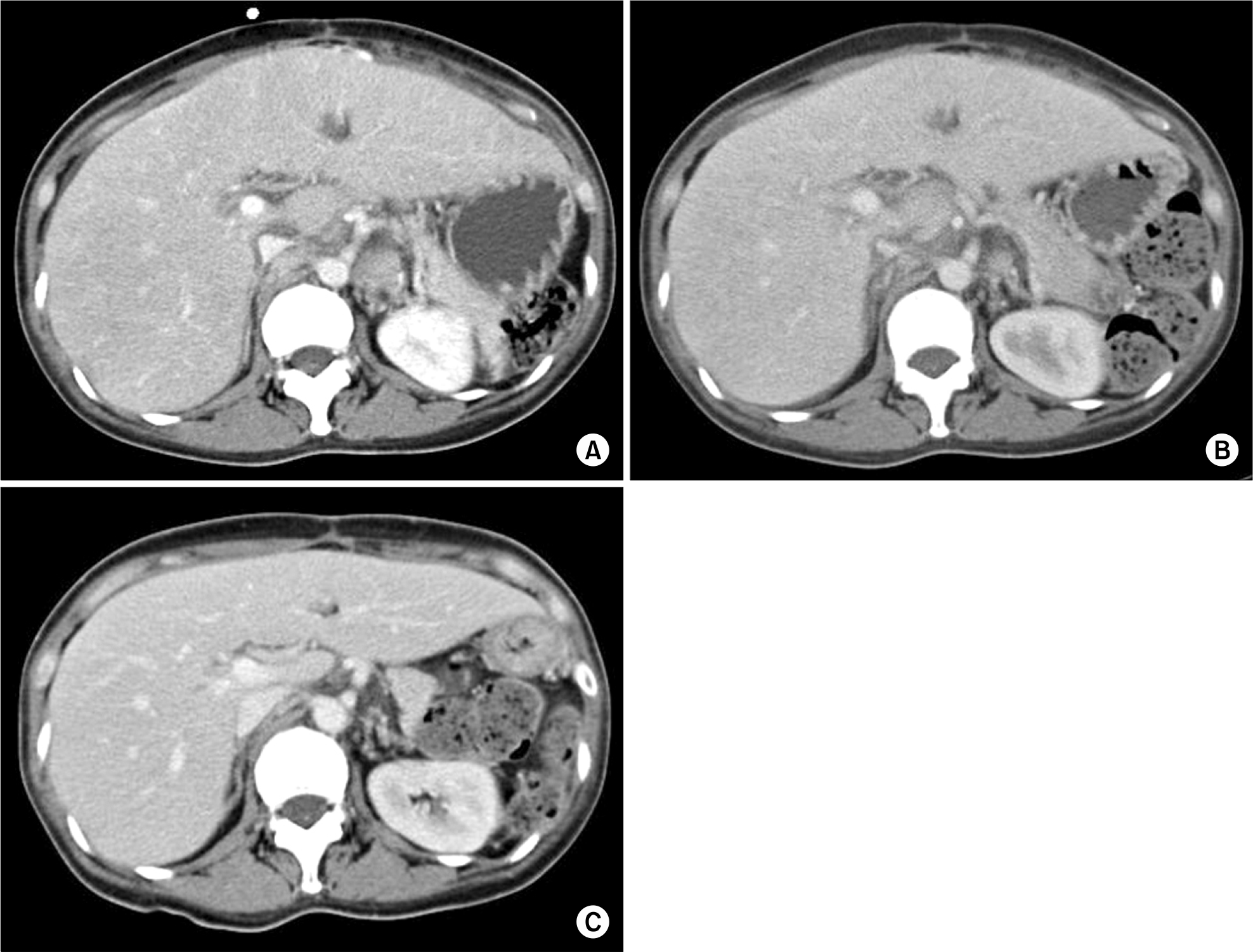Abstract
Hepatosplenic T-cell lymphoma is a rare histologic type of peripheral T-cell lymphoma, which is characterized clinically by predominant involvement of the liver and spleen, with little or no adenopathy, and an often aggressive course. We experienced a case of a 44-year-old female who was diagnosed with hepatosplenic γδ T-cell lymphoma with bone marrow involvement. The patient was treated with multi-agent chemotherapy with Bortezomib plus CHOP (cyclophosphamide, vincristine, prednisone, doxorubicin), Alemtuzumab plus DHAP (dexamethasone, cisplatin, cytarabine), and IMVP-16 (Ifosfamide, MTX, etoposide); however, she failed to achieve partial remission. After salvage chemotherapy (GemOx: Gembicine, oxaliplatin, dexamethasone), she underwent allogeneic stem cell transplantation from an HLA sibling donor with one mismatch. The patient is currently living and has remained in complete remission for 6 months since transplantation.
References
1. Harris NL, Jaffe ES, Stein H, et al. A revised european-american classification of lymphoid neoplasms. Blood. 1994; 84:1361–92.
2. Harris NL, Jaffe ES, Diebold J, et al. The world health organization classification of neoplastic diseases of the haematopoieticand lymphoid tissues: report of the clinical advisory committee meeting, air-lie house, virginia, November 1997. Histopathology. 2000; 36:69–86.
3. Belhadj K, Reyes F, Farcet JP, et al. Hepatosplenic gamma delta T-cell lymphoma is a rare clinicopathologic entity with poor outcome: report on a series of 21 patients. Blood. 2003; 102:4261–9.
4. Weidmann E, Hinz T, Klein S, et al. Cytotoxic hepatosplenic gammadelta T-cell lymphoma following acute myeloid leukemia bearing two distinct gamma chains of the T-cell receptor. Biologic and clinical features. Haematologica. 2000; 85:1024–31.
5. He S, Roberts A, Ritchie D, Grigg A. Graft-versus-lymphoma effect in progressive hepatosplenic gam-ma/delta T-cell lymphoma. Leuk Lymphoma. 2007; 48:1448–50.

6. Schafe E, Chen A, Arceci RJ. Sustained first remission in an adolescent with hepatosplenic T-cell lymphoma treated with T-cell leukemia induction, nucleoside analog-based consolidation and early hematopoietic stem cell transplant. Pediatr Blood Cancer. 2009; 53:1127–9.
7. Konuma T, Doi J, Takahashi S, et al. Allogeneic stem cell transplantation for hepatosplenic gammadelta T cell lymphoma. Leuk Lymphoma. 2007; 48:630–2.
8. Falchook GS, Vega F, Dang NH, et al. Hepatosplenic gammadelta T-cell lymphoma: clinicopathological features and treatment. Ann Oncol. 2009; 20:1080–5.

9. Park IG, Suh CW, Hur JR, et al. A case of a young woman with hepatosplenic gamma delta T-cell lymphoma. Cancer Res Treat. 2001; 33:264–8.
10. Lee SK, Woo HY, Park Q, Kim SH, Lee HG, Ko YH. A case of bone marrow involvement hepatosplenic γδ T-cell lymphoma. Korean J Hematol. 2002; 37:134–7.
11. Lee YS, Kim HJ, Park SH, et al. A case of hepatosplenic T-cell lymphoma mimicking a hemochromatosis. Korean J Med. 2006; 70:151–5.
12. Coventry S, Punnett HH, Tomczak EZ, et al. Consistency of isochromosome 7q and trisomy 8 in hepatosplenic gammadelta T-cell lymphoma: detection by fluorescence in situ hybridization of a splenic touch-preparation from a pediatric patient. Pediatr Dev Pathol. 1999; 2:478–83.
Fig. 1.
Histology and immunohistochemistry analysis of spleen (×400). (A) Atypical lymphoid cell are positively stained for H&E. (B) positvely stained for CD3. (C) negatively stained for CD4. (D) positively stained for TIA-1.

Fig. 2.
Immunohistochemical study of bone marrow (×400). Atypical lymphoid cell are positively stained for CD3.

Fig. 3.
Abdominal CT. (A) Before salvage chemotherapy shows hepatomegaly and involving the multiple lymph nodes in the perigastric, porta hepatis, and peripancreatic, and some ascites with peritoneal thickening. (B) Before transplantation after salvage chemotherapy still shows hepatomegaly but slightly decreased size of the lymph nodes (C) 6 months after transplantation, significant interval decrease in the size of liver and the multiple lymph nodes.





 PDF
PDF ePub
ePub Citation
Citation Print
Print


 XML Download
XML Download